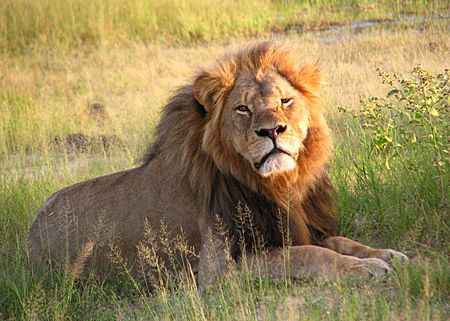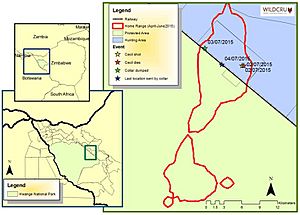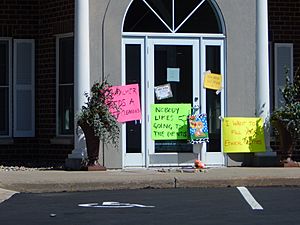Killing of Cecil the lion facts for kids

Cecil in Hwange National Park (2010)
|
|
| Species | Lion |
|---|---|
| Sex | Male |
| Born | c. 2002 |
| Died | 2 July 2015 (aged 12–13) Hwange District, Zimbabwe |
| Cause of death | Arrow wounds |
| Known for | Tourist attraction Study by the University of Oxford Death |
| Residence | Hwange National Park |
| Named after | Cecil Rhodes |
Cecil (born around 2002 – died 2 July 2015) was a famous male African lion. He lived mostly in the Hwange National Park in Zimbabwe. Scientists from the University of Oxford were studying and tracking him as part of a long-term research project.
On the night of July 1, 2015, Cecil was lured out of the park. He was then shot and wounded with an arrow by Walter Palmer, an American trophy hunter. The next morning, about 10 to 12 hours later, Cecil was tracked and killed with another arrow. He was 13 years old when he died.
Cecil's death caused a huge stir around the world. Many animal conservationists, politicians, and celebrities were very upset. This event led to new rules that made it harder for people from the United States to legally hunt lions.
Contents
About Cecil the Lion
Cecil was named after Cecil Rhodes, a British businessman. Another lion, thought to be Cecil's brother, was seen in Hwange National Park in 2008. In 2009, Cecil fought with another group of lions. His brother was killed, and Cecil was badly hurt.
After this, Cecil moved to another part of the park. He started his own group of lions, called a pride, which grew to have as many as 22 members. Later, two younger male lions pushed Cecil out of that area. He then teamed up with another male lion named Jericho. Together, they formed two prides with several female lions and many cubs.
Studying Cecil
Scientists from the Wildlife Conservation Research Unit at the University of Oxford had been studying the lions in Hwange Park since 1999. They had been tracking Cecil's movements since 2008. Cecil was easy to spot because of his black-fringed mane and a GPS tracking collar.
Cecil was very popular with tourists. He was used to people and often allowed vehicles to come very close. This made it easy for visitors and researchers to take his picture and watch him. Because of this, Cecil became the main attraction at Hwange Park.
Cecil's Death
In June 2015, Walter J. Palmer, an American dentist and hunter, reportedly paid about $50,000 to a hunting guide in Zimbabwe. This payment was to allow him to hunt a lion. On the evening of July 1, the guide and a tracker set up a hidden spot on a private farm near the park.
Between 9 p.m. and 11 p.m., Palmer shot Cecil with an arrow from his compound bow. The lion was badly wounded. The hunters then tracked Cecil for 10 to 12 hours. The next morning, they killed him with a second arrow. The hunt happened just outside the protected Hwange National Park, but it was still within Cecil's usual home area.
Cecil had a satellite tracking device that recorded his location every two hours. This data helped investigators understand what happened. The hunters also removed Cecil's tracking collar, which was later found dumped far away.
Two Zimbabweans involved in the hunt were arrested by the police. Palmer had already returned to the United States. He said he trusted his guides to make sure the hunt was legal. He also said he deeply regretted that his hunting activity led to Cecil's death.
Global Reactions
Cecil's death caused a huge international reaction. Many people around the world were very upset.
In Zimbabwe
At first, many people in Zimbabwe did not know about Cecil. But his death soon affected the country's tourism. Many international tourists who wanted to see Cecil cancelled their trips. Officials said this caused a big loss of money for Zimbabwe's tourism industry.
Zimbabwe's environment minister, Opa Muchinguri, said that Palmer broke Zimbabwean law. She asked for him to be sent back to Zimbabwe to face charges. She also said Palmer's actions hurt Zimbabwe's image.
Around the World
Many animal conservation groups and celebrities spoke out against Cecil's killing. Palmer received many angry messages and threats. People even spray-painted "Lion Killer" on his vacation home. Artists created special artworks to honor Cecil.
However, not everyone overseas felt the same way. Some people, including an African student in the U.S., pointed out that lions are often seen as dangerous animals in African villages. They felt that people in Western countries cared more about African animals than about African people.
Cecil's death also led to important discussions about trophy hunting. Three major airlines in the U.S. (American, Delta, and United) decided to stop carrying hunting trophies on their planes. Many people signed an online petition called "Justice for Cecil," asking Zimbabwe to stop giving out hunting permits for endangered animals.
The Safari Club International suspended Palmer's membership. This group supports ethical hunting. Late-night TV host Jimmy Kimmel helped raise a lot of money for the Oxford research unit that studied Cecil.
Government Responses
Some government leaders also spoke out. The Prime Minister of the United Kingdom, David Cameron, said his country was working to stop illegal wildlife trade. A U.S. Congresswoman suggested an investigation into Palmer.
U.S. Senator Bob Menendez introduced a bill called the "CECIL Animal Trophies Act." This bill aimed to make it harder to import trophies from protected animals into the U.S.
The United Nations General Assembly also passed a resolution to fight illegal wildlife poaching. Germany and Gabon, who sponsored the resolution, linked it to Cecil's death. They said it was a concern for all African countries.
Conservation Efforts After Cecil
Five months after Cecil's death, the U.S. Fish and Wildlife Service added certain types of lions in India and parts of Africa to the endangered species list. This made it much harder for U.S. citizens to legally hunt these protected lions.
Experts said that Cecil's death really changed how people viewed trophy hunting around the world. It made it harder for governments to allow such hunts. While Cecil's death wasn't the only reason for the new rules, it certainly brought a lot of public attention to the issue.
Other countries also took action. France and the Netherlands banned the import of lion trophies. Money raised because of Cecil's death has been used to help researchers reduce conflicts between people and lions. This includes paying for "lion protectors" and other methods to keep lions safe.
The "Cecil Effect"
Some people use the term "Cecil effect" to describe what happened after Cecil's death. They believe fewer hunters came to Zimbabwe, which led to more lions in some areas. However, not everyone agrees. Some say the drop in hunters was due to other reasons, like a weak economy.
Others believe the "Cecil effect" made some hunting guides afraid to shoot lions, even when necessary for safety. This fear came from the worry of facing strong public backlash, like what happened after Cecil's death.
Books and Other Media
Cecil's story has been told in books and documentaries.
- The children's book Cecil's Pride (2016) by Craig Hatkoff and his daughters tells about Cecil's life and his pride. It uses photos from researchers who studied Cecil for many years. The book highlights Cecil's relationship with Jericho, who became co-leader and then leader after Cecil's death.
- Andrew Loveridge, a researcher, wrote Lion Hearted: The Life and Death of Cecil & the Future of Africa's Iconic Cats (2018). He suggests that the hunters let Cecil suffer for a long time.
- In 2021, National Geographic Channels aired a documentary called Cecil: The Legacy of a King.
See also
 In Spanish: Cecil (león) para niños
In Spanish: Cecil (león) para niños



